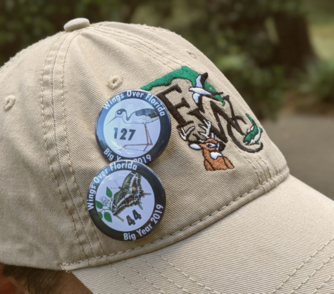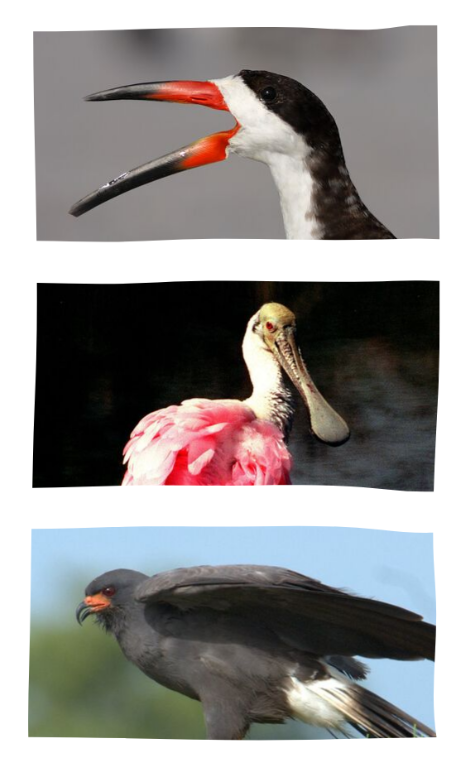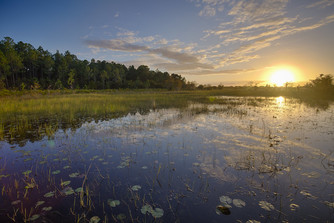 We’re busy working on designs for our new pins so you can proudly display your Wings Over Florida Big Year total!
We are well out of the summer birding doldrums and into fall migration – time to get back outside and add the passing migrants to our Florida Big Year lists! Fall is also a great season to go butterfly watching, as temperatures in the middle of the day, when they are most active, become more comfortable for us.
As long as you have seen at least 50 bird species or 20 butterfly species this year, you qualify to receive our bird or butterfly Florida Big Year certificates! This year’s certificates feature beautiful artwork of the Black-necked Stilt and the critically endangered Schaus’ Swallowtail butterfly, and will have your name printed next to your final species count. New this year, we will be sending out big year pins so you can proudly display your Big Year count! We hope that our big year recognitions will become a fun tradition for birders across the state.
 Birds have a tremendous variety of bill shapes suited to their specific diets and foraging habits. Pictured (top to bottom): Black Skimmer, Roseate Spoonbill, and Everglades Snail Kite
Generations of scientists and naturalists have been entranced by the stunning diversity of birds, with their marked variation in size, shape, vocalization, behavior and plumage. For the next few months, we will be dedicating a section of this newsletter to exploring how and why birds exhibit such variety.
Specialized bird bill shapes are the classic example of natural selection in action. We all remember the story of Darwin describing the different bills of the closely-related finches of the Galapagos, all uniquely adapted to a specific source of food. Here in Florida, we have a few species with truly wild bill shapes, which are all related to how the birds forage and what they eat.
Our Roseate Spoonbills’ unique adaptation is right in the name – the ends of their bills are very flat and broad, resembling a spoon. They forage by submerging the tips of their bills in shallow water and sweeping back and forth until they find their prey, then – snap! – they grab a tasty treat with their broad bills.
Black Skimmers are gorgeous and graceful birds in flight, but when they aren’t flying above the surface of the water, their oddly-proportioned bill is reminiscent of a severe underbite. When they forage, the birds fly with their bills open and their oversized mandible slicing through the surface of the water, searching for fish and crustaceans. The second they touch their prey, they snap their bills shut – an impressive feat while traveling at over 20 mph!
An Everglade Snail Kite’s bill might be less bizarre than the other birds on this list, but it is not less unique. These birds feed almost exclusively on apple snails, which they grab out of the water with their talons. They then use their uniquely hooked bill to extract the snails from their shells. Historically, Florida’s Snail Kites ate Florida apple snails. In the past few decades, however, our native apple snails have been outcompeted by a larger invasive species of apple snail. This could have spelled big trouble for our already vulnerable population of Snail Kites, but in a surprising twist, the birds actually increased their bill sizes in response! While this has helped the birds survive a shift in available food sources, they still face very serious threats from habitat destruction and degradation.
The response of Snail Kites to changing prey is a fortunate development, but most highly specialized species don’t fare so well in the face of change. The diversity of the natural world is incredible, and some of the most fascinating plants and animals have carved out unique niches for themselves. The specializations that make them so unique also unfortunately put them at risk, since even a small change in their environment can be devastating. Think of a monarch butterfly's reliance on milkweed to complete its life cycle, or a Florida Scrub-Jay's dependence on scrub oak habitat - if we lose the resources they need, we will lose these animals. If we want to hold onto these species, we need to protect the wild spaces where they live from development and degredation.
 Photo by David Moynahan, FWC
Just 16 miles south of Orlandp, Split Oak Forest Wildlife and Environmental Area provides ample opportunities for birding and exploring along a network of unpaved roads and over nine miles of marked trails. This WEA has pine flatwoods, hardwood hammock, oak scrub and sandhill habitats; it is also bordered by two lakes fringed by cypress swamps and wet prairies. The diverse landscape is host to an equally diverse array of species, including gopher tortoises, fox squirrels, Northern Bobwhites, Bachman’s Sparrows and Eastern Meadowlarks. Searching for migrating species can be especially productive in the scrubby oaks just east of the parking area. The eBird list for the site has 137 species, and the iNaturalist project includes observations of over 800 species, including pitcher plants, gorgeous wildflowers and beautiful butterflies.
The time is right to visit Split Oak Forest WEA – as fall approaches, biting insects and humidity will be less unpleasant, and migrating species will be passing through! Whether you live in the Orlando area or are one of the region’s many visitors, why not take a quick trip to escape the hustle and bustle of the city and explore natural Florida’s wonders? For a longer getaway, be sure to reserve a campground at the adjacent Moss Park, which connects via a trail to the WEA.
Address: Clapp Simms Duda Rd., Orlando, 32832
Hours: ½ hour before sunrise to ½ hour after sunset
Phone: 407-254-6840
September 20 – Space Coast Audubon Monthly Meeting and Potluck (Rockledge)
September 21 – Cleanup at St. Augustine Road Fish Management Area (Jacksonville)
September 21 – Eaglewatch Training (Jacksonville)
September 22 – Guided Bird Walk at Anastasia State Park (St. Augustine)
September 23 – Litter Gitter II Shorebird Habitat Cleanup (St. Augustine)
September 26 – Red-cockaded Woodpecker Habitat Talk (Brooksville)
September 27 – Beginner Birding Walk (Brooksville)
September 27 – Nature Walk (Silver Springs)
September 28 – Scrub-jay Trail Day (Clermont)
September 28 – Introduction to Birdwatching Presentation (Ocala)
September 29 – West Side Industrial Park Birding Field Trip (Jacksonville)
October 5 – Scrub-jay Trail Orientation (Clermont)
October 5 – Insect Safari (Oakland)
October 6 – Jekyll Island Banding Station (Jekyll Island, GA)
October 7 - Hernando Audubon Birding Trip to Dixie Shores (Crystal River)
October 8 – Homeschool Class Series – Creatures of the Night (Oakland)
October 11 – 13 – Festival of Flight and Flowers (Lake County)
Check out the events page of our website for more events across the state!
Do you know about any other bird- or wildlife-related events going on in Florida? Help spread the word by letting us know! Send in the times, dates, locations and contacts to wildlifeviewing@myfwc.com for posting on the Great Florida Birding and Wildlife Trail website.
Events must be related to birds or other wildlife and must be open to the public. Examples include interpretive programming, summer camps and family programs.
Enjoying our newsletter? Please consider making a tax-deductible donation through the Fish & Wildlife Foundation of Florida to support us in our mission to promote wildlife viewing across the state and help establish the next generation of birders and conservationists.
|